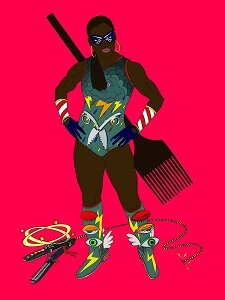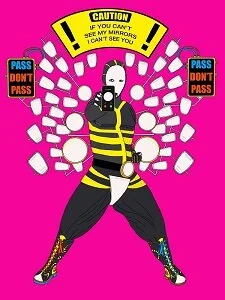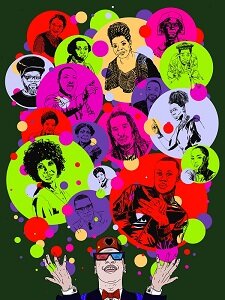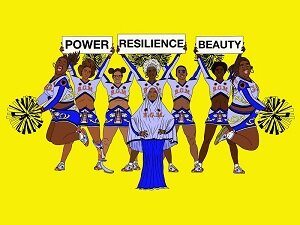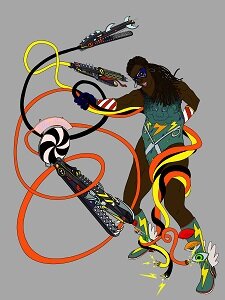A Who’s Who of Heroes & Villains
Digital print on Dibond 900x1400mm edition 1/15 £1600
M.O.B (A Tribute to Emory Douglas), 2019, Hero
With the power of computing and social media at their finger tips, young people have never been so well equipped to communicate and make positive change. By harnessing this power M.O.B can be anywhere at any time, spreading positive messages and breaking established cycles of behaviour (as symbolised by the pulling apart of the two snakes; ‘Ouroboros’ the ancient symbol which signifies infinity or continuous cycles. Emory Douglas worked as the ‘Minister of Culture’ for the Black Panthers in the 1960-70’s. By employing graphic design and screen printing techniques he created powerful propaganda that fuelled the Black Arts Movement and educated the uninformed. As an artist and as an incredibly effective agitator Mr Douglas has become a hero of mine. M.O.B is Mr Douglas’ modern day equivalent, so it felt like a very natural and appropriate decision to dedicate this print to him.
Note: This image is also available as an affordable print, as follows:
M.O.B (A Tribute to Emory Douglas), 2019, Hero
Size: 420 x 594mm (A2)
Digital Print on Archival Paper
Unframed: £125.00
The Hack digital print on Dibond 900x1400mm edition 1/15 £1600
The Hack, 2019, Villain
The central figure in this image features an atypical representation of a Journalist, but upon closer inspection we can see that all is not what it seems. The figure has 4 arms, and behind the human mask and skin coloured gloves we can see reptilian skin… on his knee is a red top newspaper claiming that ‘the face of knife crime in the UK is black’, however, a government statistic on his iPhone tells a different story. Minorities are not only overrepresented in crime story images and text, closer examination uncovers nuanced differences in the type and quality of pictures and stories by race and ethnicity. In his other hand is a fountain pen, spurting wasted ink into the air. The facts are being misrepresented and the snake like hack is projecting his own narratives. Racial bias is not just the the misrepresentation of facts about the black community in the media, it has much more far reaching effects on people’s life chances. This grave injustice is symbolized through the shadow he casts which in itself is a false representation of his true form; his hat casts the shadow of an afro, the hand holding the iPhone becomes a gun and the pen a knife.
Major Change digital print on Dibond 900x1400mm edition 1/15 £1600
Major Change, 2019, Hero
Like Bowie’s Major Tom, Major Change is on a journey into the unknown. Taking a further cue from Bowie this person is androgynous; this is a super hero that individuals of any gender or size could relate to. The costume, in addition to echoing a space traveller, echo’s the uniform and regalia worn by crusaders. Major Change suggests that by voting you can change the future and that by understanding the past the choice of vote can be an informed and effective one. A cross in a box is the standard on their shield, the HB pencil of truth is their sword. By combining the two with courage, knowledge and fortitude they can take the lead, become architects of their own destiny, take the power and forge a new future. This super hero is a modern crusader with the ability to understand the growing influence of the ethnic-minority electorate that will continue to demand greater social and racial justice, and the potential for change in our future through the empowerment of young black first-time voters. Politicians ignore Major Change at their peril because black votes matter.
Corn Row digital print on Dibond 900x1400mm edition 1/15 £1600
Corn Row (‘Row’ as in ‘disagreement’), 2019, Hero
Based on a personal experience and in recognition that just about everything relating to a person’s identity can be understood by looking at their hair, a clear and powerful signifier which is sadly still being interpreted by a white mainstream gaze. Corn Row is a powerful, strong female character who is proud of her heritage and how that birth right is presented through her appearance. She celebrates curls, curves and colour, she does not conform to the pressures or expectations placed on her by white ideals of beauty; skin bleaching, nose tucking, hair straightening. She is a defender of natural black beauty and the nemesis of the infernal hair straighteners; the ‘CONformers’. Corn Row is the Champion of natural beauty she part communicates this by sporting a style that, like the afro hair style that emerged in the the 1960s during the civil rights movement, is increasingly becoming a symbol of rebellion, pride and empowerment.
Colour Blind digital print on Dibond 900x1400mm edition 1/15 £1600
Colour Blind, 2019, Hero
There are a great many achievements and inventions that have been contributed to civilization by members of the black community throughout history. But with the exception of music and sport, these achievements and inventions go largely unrecognised, unattributed and uncelebrated. Colour Blind has the ability to conjure up these individuals and their achievements at any time he wishes, irrespective of the time the individuals lived in or in which the events took place. He can visualise characters such as Mary Seacole (born Nov 23rd 1805) who set up the ‘British Hotel’ behind the lines during the Crimean War, a peer of Florence Nightingale with similar outstanding achievements, but who for many years went completely unrecognised. Other examples include key inventions that continue to positively impact our lives, such as the pacemaker (Otis Boykin, born Aug 29th 1920), the fastest computer in the world (Philip Emeagwali, born Aug 23rd 1954), the blood bank (Charles Drew, born June 3rd 1904), carbon light bulb filament (Lewis Latimer, born Sept 4th 1848) or even Peanut Butter (George Washington Carver, born Jan 1st 1864). This image see’s Colour Blind celebrating all of theses achievements, and more in a singular space and time frame
Colour Blind can conjure up the past, he can represent the present and he can also project into the future and visualise what might happen or what should happen; a black female Prime Minister in No.10 perhaps?
The Tulsa Beast digital print on Dibond 900x1400 edition 1/15 £1600
The Tulsa Beast, 2019, Villain
The Tulsa Riots occurred in 1921 and resulted in the decimation of a whole housing district and the death of over 300 black people. This assault took place by land and air (William Joseph Simmons, Grand Wizard of the Klu Klux Klan was appointed Head of ‘The Knights of the Air’) and remains the single worst incident of racial violence in American history. Despite the scale and significance of this atrocity it remained hidden and undiscussed until 1996- have you ever heard of it? The riot was sparked by what many believe to be the chance discovery of a teenage mixed race couple making out in an elevator, others chose to believe that the teenage girl could not have willingly engaged in such a relationship and framed the event as an assault; chaos, barbarism and destruction ensued. This image tries to draw attention to the cowardly, uncaring and brutish behaviour that can occur when something that is feared (colour) cannot be reasoned or understood. History has shown us that circumstances such as these soon escalate into frustration then hate, a state of mind where even the most personable of individuals can quickly transform into blinkered, violent and uncaring beasts.
The Shadist digital print on Dibond 900x1400mm edition 1/15 £1600
The Shadist, 2019, Villain
In the absence of positive role models individuals can sometimes be pulled into the negative vacuum of the stereotypes that others chose to project. The Shadist offers them all through prejudice, bias and entrapment, allowing individuals to project or internalise detrimental and damaging self-stereotypes. The Shadist’s mirrors fall into 3 distinct categories; stereotypes that are projected onto the black community, ways in which these stereotypes are projected and the debilitating act of ‘passing’; the act of adopting the traits and mannerisms of another racial group- predominantly this has been understood as light skinned black people dressing and acting as white people in order to benefit from privileges that their true identity would deny them. Look into the Shadists mirrors, see yourself… how does it feel to be stereotyped?
Where are the Strong & Who are the Brave digital print on Dibond 900x1400mm edition 1/15 £1600
Where Are The Strong And Who Are The Trusted?, 2019, Hero
Colour Blind has gathered a collection of people, all notable in the black community from the past and the present areas of the UK and USA. When teaching children about racism it is incredibly important to highlight all the ways blacks have resisted mistreatment and persisted in the face of adversity, this includes learning about black heroes and heroines. Racial pride and black role models have been associated with better academic and mental health outcomes and can protect young black boys and girls from some of the harmful effects of discrimination. In actual fact these black people of note are from my radar, my white radar. After gathering the images together and then researching some of the individuals and getting feedback from members of the black community I came to realise that some of the ‘heroes’ I’d chosen perhaps were not as appropriate as I’d first intended, I had to revisit my selection and ask myself where are the strong and who really are the trusted?
Girl Magic #2 digital print on Dibond 900x1400mm edition 1/15 £1600
Attack The Crowd: Black Girl Magic #2, 2019, Hero
Attack the Crowd is a term used in cheerleading to describe a technique used to whip the crowd up and get them involved in proceedings; a cheer, dance or a song. A closer examination of the history of Black cheerleaders finds that they have been a conduit to galvanize those who seek social justice in the US. From the late 1950s Black male athletes were offered avenues of integration that were rarely open to Black girls, boys were allowed to play and win school games, but black girls were discouraged to cheer for them. During the late 1960s and early 70’s protests around the lack of Black cheerleaders became conduits for larger arguments about the dearth of Black professionals in schools, as well as Black coaches, administrators and students in a variety of extracurricular activities. These protests also morphed into larger demonstrations against white supremacy and racial injustice, and eventually allowed students and parents to critique integration itself, which required them to conform to white styles of cheerleading. Black cheerleading emphasized rhythmic movements, stomping, clapping and “soul-swinging”, while calls for Black cheerleaders were equally about not having to assimilate a one-sided integration that devalued their Black aesthetic and cultural expression. For the last three years, black college and high school cheerleaders have kneeled in solidarity during the national anthem to protest police brutality despite reprisals for their protest activities.
The individual from BGM portrayed in this image will get her message across to the ‘crowd’, but with her back turned to viewer she will do so in her own time and on her own terms. She’s BGM, it’s what she does.
Black Girl Magic digital print on Dibond 1660x1250mm edition 1/15 £1800
Black Girl Magic, 2019, Heroes
The term ‘Black Girl Magic’ was popularized by CaShawn Thompson in 2013 and was adopted as a rallying cry to celebrate the power, beauty, resilience and accomplishments of black women, despite the negative and harmful barriers placed in their way by society. Initially a social media campaign ‘#blackgirlmagic’, the concept has been applied to clothing, music, writing and art, being adopted by a multitude of celebrities and politicians including; Michelle and Barack Obama, Corrinne Bailey Rae, Solange Knowles and Janaelle Monáe. Black Girl Magic connects black women and creates a space to discuss the politics of hair, cultural appropriation, girl power and being black in a world where all of these things are being continuously redefined. This image of a ‘girl squad’ follows this call and celebrates all things black irrespective of ideals or stereotypes. The squad borrows its iconography from Hells Angel patches and the imagery used by American fraternities and sororities; each a collective of like minded individuals who use visual aids not only as a symbol of connectedness, but also as a motivation for success. The squad have also adopted the costume, props and actions of a cheerleading troupe, while completely disregarding the usual qualifying ideals of beauty that are applied to the joining of such groups- this isn’t about pleasing and pacifying the viewer, this is about accepting, supporting and celebrating the individual no matter their shape, shade, sexuality, disability or religion.
The Super Bus #1 digital print on Dibond 1400x900mm edition 1/15 £1600
The Super Bus #1, 2019, Heroes
Every team of Super Heroes has to have a super car! This particular hero vehicle takes its cues from the Montgomery (Alabama, USA) bus boycott in 1955 where Rosa Parks refused to give up her seat on a segregated bus. Referred to as the ‘Mother of the Freedom Movement’ and referred to as the ‘First Lady of Civil Rights’ by the United States Congress Rosa played a pivotal role in the civil rights movement. So it was surprising to discover that nine months prior to this action the very same act of positive defiance in the very same town was perpetrated by a 15-year-old unmarried mother. Claudette Colvin was arrested on March 2nd, 1955, for not giving up her seat to a white woman on a bus in Montgomery, Alabama.
In this image, Rosa Parks, is a Lollipop Lady, performing the important role of guiding passengers safely onto the bus, but as indicated on the driver’s sun visor, it is ‘Claudette Colvin No.1’ who will lead the way and drive them to their destination. The imagery on the bus echo’s the decorative elements used by the drivers of idiosyncratic buses in the Caribbean and the haulage trucks of India. The Lolly Pop Lady and the array of Mod mirrors bring us back to the UK.
The Attack of the Killer Hair Straighteners digital print on Dibond 520x750mm edition 1/15 £1000
Corn Row And The Attack Of The Hair Straighteners, 2019, Hero
“Do not remove the kinks from your hair- remove them from your brain” was the advice Marcus Garvey gave to individuals adopting Caucasian epitomes of beauty instead of embracing their own natural beauty. The early relaxed hair aesthetic brought with it a perceived social status and progress that Black people desired, in a society that deemed African features such as ‘nappy’ hair repulsive. The struggle continues against hair texture discrimination and is very real in this image; the ideals have manifested themselves as part mechanical, part organic hybrids; the CONformist’s. Hell bent on forcing their standards of good and and bad hair and identity onto all. Only one person can defeat them; Corn Row, a defender of the Natural Hair Movement. But with the onslaught of European beauty standards it can seem impossible to redefine the distorted hair metrics through which Black women are assessed (in the 1990’s Andre Walker’s Hair Typing System offered a visual hair hierarchy that placed straight hair at the top as Type 1, and kinky/coily hair as Type 4) where once again black women are left at the lower end of the list - even heroes can be overwhelmed at times. Can Corn Row persevere in decolonising beauty? The basis for the composition of this image is a powerful sculpture by Frederic Leighton, which I have admired for a long time. ‘Athlete Wrestling a Python’, 1877 can be found in Tate Britain and is recognised as the first move in the UK from classical to modern sculpture. I greatly admire the craftsmanship, the dynamism and the scale of this piece, but in particular I love the fact that this artefact heralds the start of a new era, a new approach, a new way of thinking not just for one, but for all.




